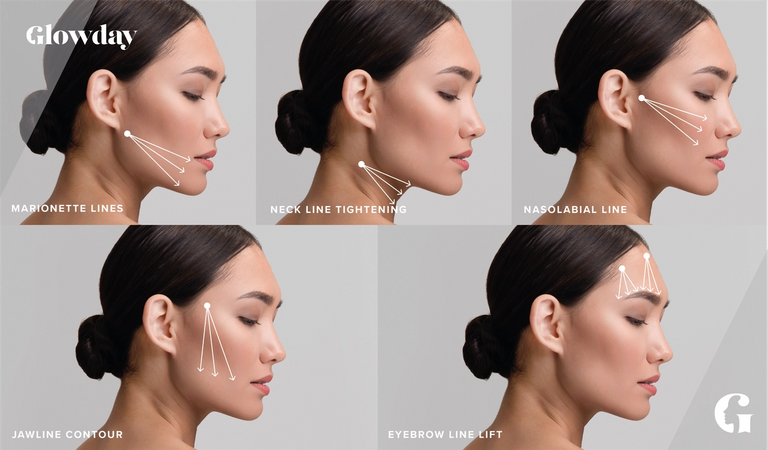At A Glance
Top Questions
Thread Lifts Overview
Often termed the ‘lunchtime facelift’, thread lifts are a relatively new, non-surgical procedure that are a great alternative to the traditional facelift. Whilst they don’t give the same dramatic effect as a facelift (as they can only lift the face a few millimetres) the results are noticeable, immediate, reasonably long-lasting and can delay the need for a surgical facelift. They are also a good compromise for those who are reluctant to ‘go under the knife’ and want a subtle improvement.
Thread lifts are used to treat general signs of ageing, such as sagging skin as a result of the deflation of underlying tissue. This leads to jowl formation, deepened nasolabial folds and more prominent marionette lines. The treatment is ideal for those in their late 30s to 60s who are bothered by skin laxity and sagging.
Popular brands of threads include:
- Silhouette Soft® (which offers a mechanical lift and biological stimulation of collagen production)
- APTOS®
- Contour LiftTM
- Silk LiftTM
- Feather LiftTM
Thread lifts have a double restorative effect. Not only do they instantly lift the skin, moving it into a more youthful position, they also stimulate cell renewal and collagen production in the treated area.
Carried out in under an hour and allowing you to return to a fairly standard daily routine, thread lifts don’t come with the same level of downtime as surgical facelifts.
This Glowday Treatment Guide has been guest edited and medically verified by Dr Nestor.
How do thread lifts work?
Poly-L-lactic acid (PLLA), Poly Lactic-co-Glycolic acid (PLGA) and Polydioxanone (PDO) threads are surgical sutures which are resorbable. This means that, over time, they break down and are absorbed by the body, so their effects are temporary (1 – 3 years) and risk of reaction, downtime and infection are reduced compared to a surgical facelift. As they are breaking down, they stimulate collagen production.
The threads/sutures are placed beneath the skin, into the underlying fat layer about 5mm underneath the surface of the skin. The threads are then gently pulled to achieve the desired lift and tightening effect. Once in place, the threads are then trimmed.
Not only do the threads physically lift and reposition sagging skin, the controlled trauma they cause leads to additional collagen synthesis in the treated area, further increasing the rejuvenating effects of the thread lift.

Who are thread lifts for?
Thread lifts are typically advised for those who have general signs of ageing, such as hollow or mildly sagging cheeks, jowls and loss of contour and definition.
They are often used as a way of delaying a surgical facelift or for those who want a subtle improvement. Most candidates are in their late 30s to 60s.
How should I prepare for a thread lift treatment?
You should avoid the following 48 hours prior to your treatment:
- Alcohol
- Aspirin
- Ibuprofen
- St John’s wort
- Fish oils
To help prevent bruising, you may be advised to take a 10-day course of arnica tablets prior to your treatment.
Additionally, since vitamin C assists collagen production, taking a high-quality vitamin C tablet may be advised.
It is a good idea to arrive at your appointment with thoroughly cleansed skin.
What happens during a thread lift treatment?
Step One - Consultation and Consent
It is important to understand that thread lift procedures should only be carried out by medically trained professionals. Your consultation and treatment should not be on the same day (unless you have discussed it over the phone with your medical professional). This will allow you time to consider everything that was covered in your consultation, including the risks, and allow a 'cooling off' period.
Step Two - The Thread lift Treatment
Your practitioner may apply a topical numbing cream as well as injecting a local anaesthetic into the area to be treated.
Threads are placed into the fat layer of the skin, 5mm beneath the surface, using a needle or cannula.
Step Three - The Check up
It is advisable to book a check-up with your practitioner 2 weeks following your treatment.
If you have any concerns prior to this appointment, contact your practitioner.
What happens after a thread lift treatment?
Do:
- Sleep on your back for about 2-4 weeks
- Keep hydrated
- Use over the counter pain medication as necessary (avoid ibuprofen as it promotes bleeding and therefore bruising)
- Ice any swelling
- Avoid sun exposure, alcohol and cigarettes
- Keep the area very clean until the small holes close over (72 hours)
Don’t:
- Touch the treated area for at least 4 hours after your treatment
- Use make up for 24-48 hours after treatment
- Sleep on the treated area for at least 3 days
- Do strenuous exercise for 14-28 days
- Plan any laser treatments during the month following your treatment
What are the side effects and risks of thread lifts?
Following a thread lift treatment, you will likely experience mild bruising, swelling, some muscle weakness and soreness for a week or two. You may also feel a tightening sensation around the threads. This can be managed with arnica and over the counter pain medication.
Rarely, infection, nerve injuries and migration of threads have been reported.
Additionally, some people may experience contour irregularities, scarring and skin dimpling.
Thread lift procedures should only be carried out by medically qualified practitioners, thus reducing the chance of these rare side effects.
How much do thread lifts cost?
Thread lifts are charged per thread.
You can expect to pay the following:
- 1 thread £500
- 2 threads £950
- 3 threads £1400
Glowday Disclaimer
All information in our Glowday Treatment Guides and blog articles is intended for reference and information. The information given here is to help you make informed decisions when considering the wide range of non-surgical aesthetic treatments available.
It is NOT intended as medical advice. Any reliance placed by you on the information contained within the Glowday Treatment Guides, Glowday blog articles or on any of Glowday.com is done by you at your own risk.
Before undergoing any non-surgical cosmetic treatment mentioned anywhere on Glowday.com, you should fully consult with an appropriately qualified and accredited practitioner who is properly trained in and fully insured to conduct the treatment you are interested in. Neither the author of the guides or blog articles, or the practitioner who has verified the guides nor Glowery Limited can be held responsible or liable for any loss or claim arising from the use or misuse of the content of Glowday.com.

